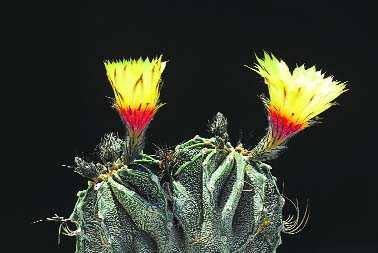
CACTI DICHOTOMOUSLY BRANCHING ASTROPHYTUM CAPRICORNE
Maj Gen C S Bewli
Cacti are not merely desert plants having sharp and painful spikes as is generally thought of, they are perhaps the most unique ornamental plants for decorating homes and gardens. These are much sought after by gardening enthusiasts and are a collector's delight. Most of these ornamental plants are exclusively outlandish in character and are distinguished by their unusual features in the category of:
- Cristates and monstrose forms
- Dichotomously branching cacti
- Variegated cacti
- Cacti without chlorophyll
Cristates and monstrose forms
As in other plants, cacti also develop abnormal type of growth forms known as cristates and monstrose; they are catalysed naturally by genetic mutation. They appear as a seedling or as a branch on an otherwise normal cactus and there is no human involvement in their creation. These forms of cactus are highly priced and are cultivated for their stunning shapes and the ability to attract attention. They sometimes get variegated (coloured).
They are less robust as compared to their normal forms due to deficiency of chlorophyll and need additional care as they
- Are more prone to issues such as red spider mites, mealy bugs and sunburns.
- Have a tendency to revert to their normal growth pattern which should be removed from the plant with a sharp razor during its growth period. In cultivation, they are propagated by cuttings or by grafting.
Cultivation tips
- They should be grafted on to tall stocks.
- They should not be watered from the top as moisture that remains in the folds of their body can cause rot.
- Grow them under bright indirect sunlight.
- Fertilise them once in growing season with NPK and some bone meal.
Dichotomously branching phenomenon
The process of division of the top of a plant into two parts or heads is called dichotomous branching. It is an unusual ability of a plant that initially starts with a single head, but as it grows, the top widens to allow division of the single growing tip into two similar growing tips. During the process of its further growth, these two tips further divide into four heads, then eight heads and so on. As the plant matures, the process of division continues in various heads to form stunning clusters. These plants are commonly known as Owls Eye Cactus due to their distinct owl-eyed appearance when seen from above.
Dichotomously branching is not a common occurrence in cacti. In some species of the genus Mammillaria, this phenomenon is regular, but it's a unique feature in other genera. Mammillaria species which exhibit this extraordinary feature are Mammillaria karwinsikiana, M. parkinsonii, M. nejapensis, M. microthele, M. perbella, M. muehlenfordtii, M. huitzilopochtli, M. rodhantha, M. crucigera and some more.
Propagation is carried out by seeds, cuttings or offsets.
Variegation
Variegation in cacti is the appearance of different coloured zones on their stem in the pattern of stripes, patches or spots. This form of genetic transformation prevents the production of desired amount of chlorophyll due to presence of coloured portion; this affects the plant's metabolism and results in low resistance to strong sunlight and the plants inability to produce enough chlorophyll to survive in too little light. Being less robust than their green counter parts, they have slower rate of growth and need more care.
In some cases variegation is stable; in other cases the plant reverts back to its green growth form. Variegates with hardly any chlorophyll need to be grafted, but others grow well on their own roots.
Tending tips
- Water when the top soil dries up during summers and in winters reduce watering to once in a fortnight.
- To avoid sunburns and to protect their bright colours, do not put them under direct sunlight.
Cacti without chlorophyll
Most of the cacti occur in verdant shades of green, but some varieties of Gymnocalycium mihanovichii do not have any green pigment. In the absence of green pigment or chlorophyll, these plants assume vibrant pigments in shades of red, orange and yellow to display their unique splash of colouration.
These plants do not survive on their own roots due to their inability to manufacture food through the process of photosynthesis. They are always grafted on to vigorously growing rootstocks to draw nutrients. They are commonly called coloured caps or lollipops.
A cactus without chlorophyll gives an impression of a flower-like plant. These plants are often mistaken to be beautiful flowers and appear to bloom day and night; they last for about a couple of years on graft.
Cultivation tips
- Do not water these plants from top to avoid the joint of the graft from rotting.
- Water them as normal house plants during growing season and in winters reduce watering to once in a fortnight.
- Do not put them under direct sunlight.
- ertilise with NPK and bone twice during growing season.
Propagation is carried out by grafting offsets which appear at the base or even on the body of the grafted plant.
— The writer is President of National Cactus & Succulent Society of India


























